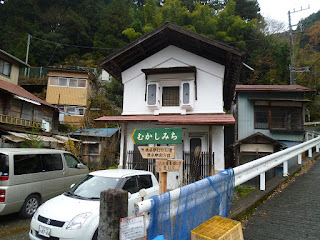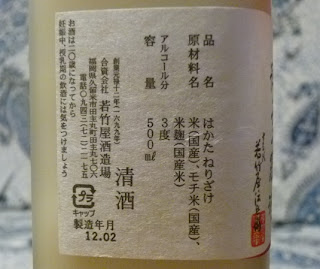Okutama
Lake, nestled among mountains in Okutama Town, the western part of Tokyo, is an
artificial lake backed up by Ogochi Dam. The construction of the dam started in
1938, and was completed in 1957 after having been interrupted by the war for a period
of several years.
From
the Okutama Station to Ogochi Dam, you can take a bus, which drives along Japan
National Route 411. The road in this section goes along the mountain stream of
Tama River, passing through sporadic tunnels. This road is of course essential
for people living in this area, but before this road was constructed, they were
using an old road, which is now called Okutama Muakashi-michi (literally, old
road in Okutama).
Okutama
Mukashi-michi, an about 10-km community road, was made in 1899 to replace the
about 14-km mountain path connecting the Hikawa district and Ogochi district,
and this Okutama Mukashi-michi became a very important path for people in the
area. Along the path, there were shrines, temples, teahouses, water vessel for
horses bringing baggage or people, etc.
In
1945, the new road, which had been constructed earlier originally for
transporting material for the construction of Ogochi Dam, became open to the
public, and people became able to use this road for their living. Consequently,
the importance of Okutama Mukashi-michi reduced and people became to use the
new road more often than this old path.
Some
sections of the Okutama Mukashi-michi path are paved with asphalt, and we can
see cars and trucks go up and down in these sections. However, some sections
are very narrow paths, some sections consist of only a few flights of stairs,
and even some sections are mountain trails. There were guideposts at every key
location and it is easy for visitors to stay on the right track, and there are
benches to take rest and well-maintained public restrooms along the road. So,
anyone can enjoy a holiday walk at ease.
It
seemed there were many interesting spots to see, and I decided to go for a walk
along this road on a late autumn day.
(Start
point of the road)
With
some food and drink in a daypack, I started Okutama Station about 10:00 a.m.,
and soon reached the start point of Okutama Mukashi-michi. From the beginning,
I needed to walk up a steep asphalt-paved slope, called Haguro-zaka. Halfway on
the slope, I found a tori gate on the
right. There were stone stairs behind the tori
gate. The stairs had to lead to a shrine and I thought I should pay respects to
the god enshrined, so I started walking up the stairs, which was longer than I
expected. When I finished two flights of stairs, I was in a small open space,
and it turned out that the stairs I had been struggling up was just a part of
the long approach to the shrine, because I found across the open space a
guidepost indicating the way to the shrine. So, I gave up visiting the shrine
and went down the stairs back to the main route.
After
leaving the tori point, soon the
route entered a narrow path. Soon, this walkway began to run along a defunct railroad
track on the left. This track was used in the past to transport material for
the construction of the dam. I walked on the walkway along the railroad track
for a short while, and then the walkway curved rightward to leave the railroad
and then leftward to gradually climb up, reach the railroad track, and go over
the tunnel through which the track was further extending.
(Defunct
railroad track)
Then,
the narrow path connected to a wider asphalt-paved road, and soon I reached the
point where a well-maintained house of public facilities. Inside the house,
there is also a place for walking passengers to take a rest.
(Well-maintained
public restroom along the walkway)
The
walkway went through mountains and I walked admiring beautiful autumn leaves
here and there.
(Road
in mountains)
At
some points, I could see some part of that railroad track. In a small community
called Sakai, I found a railroad bridge above my way. The railroad seemed to
have been running almost parallel to the walkway, and I could see its remnants
while walking.
(Railroad
bridge)
The
walkway was generally very comfortable to walk, relatively even, not hard to
walk (just a short part in the beginning and about an-hour part in the last
were mountain trails).
After
leaving the Sakai community, I soon reached the Shirohige Shrine. In this small
shrine, a big rock is enshrined as the object of worship. In summer, sanbiki shishimai dances (a type of
local performing arts performed by three dancers with headgear resembling the
heads of lions, other dancers, and musical instrument players such as bamboo
flutists) are performed in the precincts of this shrine as offerings to the
god. I have seen their performance before, and it was very interesting.
(Stone
stairs leading to the Shirohige Shrine)
(The
tilted huge rock on the right of the shrine house is the object of worship.)
In
a few-minute walk distance from the shrine, I found a maple tree beautifully
decorated with red and yellow leaves. The colors of this tree seemed to be
brightening up things around this point.
(Iroha-kaede: Japanese maple)
The photo below shows a water vessel
for horses to drink. According to the description on the board, there were
three teahouses around here so that passengers can rest for a while. The
teahouses were selling snacks, udon
noodles, bean-paste buns, tobacco, etc. Guests could even drink cups of sake.
(Water vessel for horses to drink)
I had been walking for over three
hours since I started walking when it was around 1:30. I felt very hungry and I
had been looking for a nice place to have a rest and eat my lunch. And, I
finally found a perfect place for my lunch. The place was overlooking the
valley, and there were tables and benches surrounded by trees with yellow,
orange, red-colored leaves.
(Lunch place!)
After having the lunch, I started
walking again and soon the walkway left the asphalt-paved road and turned into
a trail in mountains. The walkway was most arduous in a section beginning from
this point. However, I like walking on a mountain trail while seeing beautiful
trees and leaves. I think this part was the most interesting for me.
(Point where the asphalt road ends and
the mountain trail starts)
(Trees with autumn leaves)
(I like walking on fallen leaves.)
At a point close to the end of this
walkway, there is a nice lookout platform beside a teahouse named Aome-fudoson
Rest Station. From the platform, I could overlook Okutama Lake. I enjoyed a
nice lake view.
(Guidepost indicating Aome-fudoson
Rest Station)
(Lake view from the lookout platform)
From here, I got to the Mizune bus
stop in 30 minutes or something to end my walk this day. It was fun to walk along
this old path while enjoying nice views of the valley, mountains, and autumn trees,
and giving more than a passing thought to life of people who lived in this area
in olden days.
(Movie)



































